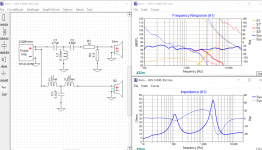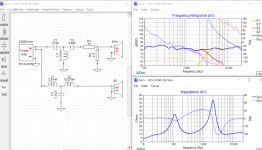The woofer is nearly 87dB nominal according to specs and the curve.
Now most people target 3 - 6dB compensation. As noted above, listening distance, front wall re-inforcement, baffle size all affect how much or how little.
It means your system response will be between 81dB and 84dB for most situations. your current response has at best 2dB BSC. whether this is enough... I don't know.
What enclosure alignment are you using for the TB W3-2001S?
Basically what I am saying. is I start with a target sensitivity. This is driven by woofer capability and BSC. Get this wrong, and forget your crossover design (as change in BSC by and large ripples through changing everything else).
Now most people target 3 - 6dB compensation. As noted above, listening distance, front wall re-inforcement, baffle size all affect how much or how little.
It means your system response will be between 81dB and 84dB for most situations. your current response has at best 2dB BSC. whether this is enough... I don't know.
What enclosure alignment are you using for the TB W3-2001S?
Basically what I am saying. is I start with a target sensitivity. This is driven by woofer capability and BSC. Get this wrong, and forget your crossover design (as change in BSC by and large ripples through changing everything else).
These may not be right.
I don't see the point in crossing a 3" fullrange to a tweeter, what the 3" is missing is the bass not the highs. Moreover the choice for the tweeter is surprising, at least to me: here one of these tweeters will cost like a calibrated usb mic, I would rather spend the money on a mic and have still money left for a couple of inexpensive tweeters (for example ND20FA/B), if there is the urge to use a tweeter.
Have a good read here: Zaph|Audio
IMHO you need to understand what the baffle step effect is. You can't simply trace the mfg FR and use that in XSim, unless you are building an in-wall speaker.
Ralf
I found the driver in my storage room. How it got there I don't know
the last combination seems to be better. The tweeter is still to high in level
You have to cosider the DC resistance of the coils, add a seriell resistor.
You also have to consider the baffle step
you do not need to compensate the impedance
You have to cosider the DC resistance of the coils, add a seriell resistor.
You also have to consider the baffle step
you do not need to compensate the impedance
There will be a very high impedance peak at around 2khz. is this okay? How will this translate to real life?
You also have to consider the baffle step
Is he even using a baffle? Or is it infinite? Or a horn? Or a waveguide?
Your amplifier should not have a problem with it. A crossover normally sees an impedance peak. Yours is a little low in frequency, it makes me wonder how you arranged your filters, or the traces..
Is he even using a baffle? Or is it infinite? Or a horn? Or a waveguide?
I will use a regular baffle with a width of 15cm. The tweeter will be flush mounted while the woofer will not.
Your amplifier should not have a problem with it. A crossover normally sees an impedance peak. Yours is a little low in frequency, it makes me wonder how you arranged your filters, or the traces..
Yeah, I don't really trust the traces. But, I will try to build the crossover anyway and see how it sounds. But, before I build it, will the impedance peak cause any trouble to the amp or to the speaker? How will the impedance peak affects the sound? Thanks for your help!
Also, how do you integrate BSC into a crossover design? I read that using a larger coil on the woofer is one way. Is there another way? Thanks!
The typical audio amplifier has a low output impedance and will ignore the impedance peak by and large.
You can explore other forms of equalisation to get yourself a rise going lower in frequency.
You can explore other forms of equalisation to get yourself a rise going lower in frequency.
Also, how do you integrate BSC into a crossover design? I read that using a larger coil on the woofer is one way. Is there another way? Thanks!
A parallel inductor and resistor - both in series with the woofer (first components after the source / amp). The inductor provides only DCR impedance from 0Hz up therefore no cut to bass frequencies. As frequencies rise, the inductor starts increasing in impedance (baffle step) and current sees the lower impedance path through the resistor thus providing the fixed cut needed above the bafflestep. aka low pass shelving filter.
Both approaches are aimed at passing through low frequencies and increasing attenuation in the bafflestep band.
The benefit of the large inductor is the increasing impedance with frequency, allowing it to become part of the order filter. The L/R parallel approach provides fixed impedance, so further filter components are required. The resistor also needs to handle the upper bass / lower midrange power (30% is probably enough of the total expected speaker handling)
Last edited:
What does the impedance curve mean? I know that the lower the impedance, the harder it is to drive. Is there something else?
It's a combination of acoustic, driver and crossover related things. While it's possible to explain each variation of the impedance, it's also possible to see different curves leading to the same result. Some make sure it's drivable by the amp, some try to optimise it and some study it for what it reveals.
- Home
- Loudspeakers
- Multi-Way
- 3rd Order Crossover Reverse Null

